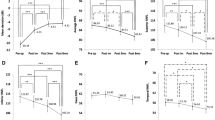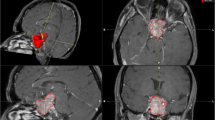Abstract
Purpose
To analyze the factors influencing visual field recovery in patients with pituitary adenoma following surgical treatment.
Methods
We retrospectively reviewed 144 eyes of 72 patients with pituitary adenoma who had been followed up for more than 6 months following surgery between January 2016 and December 2019. Pre and postoperative visual acuity, visual field test and retinal nerve fiber layer (RNFL) thickness were investigated. We defined recovery of visual field defects as being an improvement in mean deviation (MD) of 2 dB or more.
Result
The average age of the 72 patients (144 eyes) was 51.94 ± 14.69 years, making for 37 patients in the recovery group and 35 patients in the non-recovery group. Preoperative MD, pattern standard deviation (PSD), and visual field indexes (VFI) were negatively correlated to postoperative MD, PSD and VFI changes and positively correlated to postoperative MD, PSD, and VFI values. Using multiple regression analysis, a shorter duration of symptoms (Odds ratio [OR], 0.990; p = 0.033), higher preoperative MD values (OR, 0.871; p = 0.025), and thicker temporal RNFL (OR, 1.068; p = 0.048) were associated with a visual field recovery following surgery.
Conclusions
The prognosis for visual field recovery is favorable for patients who have a short period from symptom onset to surgery, a higher MD value of preoperative VF, and a thicker peripapillary temporal RNFL thickness. Therefore, the preoperative MD, temporal RNFL thickness, and the symptom period can be predictive variables affecting postoperative visual field recovery.

Similar content being viewed by others
Data availability
The datasets generated during and/or analyzed during the current study are available from the corresponding author on reasonable request.
Abbreviations
- OCT:
-
Optical coherence tomography
- RNFL:
-
Retinal nerve fiber layer
- VF:
-
Visual field
- TSA-TR:
-
Transsphenoidal approach-tumor resection
- MRI:
-
Magnetic resonance imaging
- MD:
-
Mean deviation
- log MAR:
-
Logarithm of the minimum angle of resolution
- BCVA:
-
Best corrected visual acuity
- PSD:
-
Pattern standard deviation
- VFI:
-
Visual field index
References
Anderson D, Faber P, Marcovitz S et al (1983) Pituitary tumors and the ophthalmologist. Ophthalmology 90:1265–1270
Yeh PJ, Chen JW (1997) Pituitary tumors: surgical and medical management. Surg Oncol 6:67–92
Symon L, Jakubowski J (1979) Transcranial management of pituitary tumours with suprasellar extension. J Neurol Neurosurg Psychiatry 42:123–133
Kerrison JB, Lynn MJ, Baer CA et al (2000) Stages of improvement in visual fields after pituitary tumor resection. Am J Ophthalmol 130:813–820
Laws ER Jr, Trautmann JC, Hollenhorst RW Jr (1977) Transsphenoidal decompression of the optic nerve and chiasm: visual results in 62 patients. J Neurosurg 46:717–22
Powell M (1995) Recovery of vision following transsphenoidal surgery for pituitary adenomas. Br J Neurosurg 9:367–373
Svien HJ, Love JG, Kennedy WC et al (1965) Status of vision following surgical treatment for pituitary chromophobe adenoma. J Neurosurg 22:47–52
Ciric I, Mikhael M, Stafford T et al (1983) Transsphenoidal microsurgery of pituitary macroadenomas with long-term follow-up results. J Neurosurg 59:395–401
Findlay G, McFadzean RM, Teasdale G (1983) Recovery of vision following treatment of pituitary tumours: application of a new system of visual assessment. Trans Ophthalmol Soc UK 103:212–216
Lennerstrand G (1983) Visual recovery after treatment for pituitary adenoma. Acta Ophthalmol 61:1104–1117
Gnanalingham KK, Bhattacharjee S, Pennington R et al (2005) The time course of visual field recovery following transphenoidal surgery for pituitary adenomas: predictive factors for a good outcome. J Neurol Neurosurg Psychiatry 76:415–419
Cohen AR, Cooper PR, Kupersmith MJ et al (1985) Visual recovery after transsphenoidal removal of pituitary adenomas. Neurosurgery 17:446–452
Ogden TE (1983) Nerve fiber layer of the primate retina: thickness and glial content. Vision Res 23:581–587
Lee DK, Sung MS, Park SW (2018) Factors influencing visual field recovery after transsphenoidal resection of a pituitary adenoma. Korean J Ophthalmol 32:488–496
Barzaghi LR, Medone M, Losa M et al (2012) Prognostic factors of visual field improvement after trans-sphenoidal approach for pituitary macroadenomas: review of the literature and analysis by quantitative method. Neurosurg Rev 35:369–378
Anik I, Anik Y, Cabuk B et al (2018) Visual outcome of an endoscopic endonasal transsphenoidal approach in pituitary macroadenomas: quantitative assessment with diffusion tensor imaging early and long-term results. World Neurosurg 112:e691-701
Anik I, Anik Y, Koc K et al (2011) Evaluation of early visual recovery in pituitary macroadenomas after endoscopic endonasal transphenoidal surgery: quantitative assessment with diffusion tensor imaging (DTI). Acta Neurochir (Wien) 153:831–842
Luomaranta T, Raappana A, Saarela V et al (2017) Factors affecting the visual outcome of pituitary adenoma patients treated with endoscopic transsphenoidal surgery. World Neurosurg 105:422–431
Yu FF, Chen LL, Su YH et al (2015) Factors influencing improvement of visual field after trans-sphenoidal resection of pituitary macroadenomas: a retrospective cohort study. Int J Ophthalmol 8:1224–1228
Schmalisch K, Milian M, Schimitzek T et al (2012) Predictors for visual dysfunction in nonfunctioning pituitary adenomas: implications for neurosurgical management. Clin Endocrinol 77:728–734
Eda M, Saeki N, Fujimoto N, Sunami K (2002) Demonstration of the optic pathway in large pituitary adenoma on heavily T2 weighted MR images. Br J Neurosurg 16:21–29
Gondim JA, Almeida JP, de Albuquerque LA et al (2015) Endoscopic endonasal transsphenoidal surgery in elderly patients with pituitary adenomas. J Neurosurg 123:31–38
Marenco HA, Zymberg ST, de Santos RP, Ramalho CO (2015) Surgical treatment of non-functioning pituitary macroadenomas by the endoscopic endonasal approach in the elderly. Arq Neuropsiquiatr 73:764–769
Zhan R, Ma Z, Wang D, Li X (2015) Pure endoscopic endonasal transsphenoidal approach for nonfunctioning pituitary adenomas in the elderly: surgical outcomes and complications in 158 patients. World Neurosurg 84:1572–1578
Lee S, Kim SJ, Yu YS et al (2013) Prognostic factors for visual recovery after transsphenoidal pituitary adenectomy. Br J Neurosurg 27:425–429
Danesh-Meyer HV, Carroll SC, Foroozan R et al (2006) Relationship between retinal nerve fiber layer and visual field sensitivity as measured by optical coherence tomography in chiasmal compression. Invest Ophthalmol Vis Sci 47:4827–4835
Kanamori A, Nakamura M, Matsui N et al (2004) Optical coherence tomography detects characteristic retinal nerve fiber layer thickness corresponding to band atrophy of the optic discs. Ophthalmology 111:2278–2283
Monteiro ML, Leal BC, Rosa AA et al (2004) Optical coherence tomography analysis of axonal loss in band atrophy of the optic nerve. Br J Ophthalmol 88:896–899
Monteiro ML, Moura FC, Medeiros FA (2007) Diagnostic ability of optical coherence tomography with a normative database to detect band atrophy of the optic nerve. Am Ophthalmol 143:896–899
Danesh-Meyer HV, Wong A, Papchenko T et al (2015) Optical coherence tomography predicts visual outcome for pituitary tumors. J Clin Neurosci 22:1098–1104
Jacob M, Raverot G, Jouanneau E et al (2009) Predicting visual outcome after treatment of pituitary adenomas with optical coherence tomography. Am J Ophthalmol 147(64–70):e2
Jeon C, Park KA, Hong SD et al (2019) Clinical efficacy of optical coherence tomography to predict the visual outcome after endoscopic endonasal surgery for suprasellar tumors. World Neurosurg 132:e722–e731
Moon CH, Hwang SC, Park TK (2011) Postoperative visual field outcomes in patients showing visual field defects due to pituitary adenoma. Korean Ophthalmol Soc 52:726–733
Monteiro ML, Hokazono K, Fernandes DB et al (2014) Evaluation of inner retinal layers in eyes with temporal hemianopic visual loss from chiasmal compression using optical coherence tomography. Invest Ophthalmol Vis Sci 55:3328–3336
Acknowledgements
This manuscript has not been published or presented elsewhere in part or in entirety and is not under consideration by another journal.
Funding
This study was supported by a 2020 research grant from Pusan National University Yangsan Hospital.
Author information
Authors and Affiliations
Contributions
KSJ and CHY are responsible for study design and acquisition of the clinical information. PSH and KSJ are responsible for manuscript preparation. PSH, KMS, and KSY are responsible for date analysis. LJE and CHY are responsible for reviewing the manuscript. All authors read and approved the final manuscript.
Corresponding author
Ethics declarations
Conflict of interest
All authors certify that they have no affiliations with or involvement in any organization or entity with any financial interest, or other equity interest, or non-financial interest in the subject matter or materials discussed in this manuscript.
Informed consent
The institutional review board had approved the research (IRB Number: 05-2020-143). This study was retrospective, and the informed consent on subject was waived.
Additional information
Publisher's Note
Springer Nature remains neutral with regard to jurisdictional claims in published maps and institutional affiliations.
Rights and permissions
About this article
Cite this article
Park, S.H., Kang, M.S., Kim, S.Y. et al. Analysis of factors affecting visual field recovery following surgery for pituitary adenoma. Int Ophthalmol 41, 2019–2026 (2021). https://doi.org/10.1007/s10792-021-01757-6
Received:
Accepted:
Published:
Issue Date:
DOI: https://doi.org/10.1007/s10792-021-01757-6




